- Home
- Terry Pratchett
Darwin's Watch Page 8
Darwin's Watch Read online
Page 8
year later. In 1884 it reappeared as a pamphlet with the subtitle `Ghosts Explained'. Hinton, something of a mystic, related the fourth dimension to pseudoscientific topics ranging from ghosts to the afterlife. A ghost can easily appear from, and disappear along, a fourth dimension, for instance, just as a coin can appear on, and disappear from, a tabletop, by moving along `the' third dimension.
Charles Hinton was influenced by the unorthodox views of his surgeon father James, a collaborator of Havelock Ellis, who outraged Victorian society with his studies of human sexual behaviour. Hinton the elder advocated free love and polygamy, and eventually headed a cult. Hinton the younger also had an eventful private life: in 1886 he fled to Japan, having been convicted of bigamy at the Old Bailey. In 1893 he left Japan to become a mathematics instructor at Princeton University, where he invented a baseball-pitching machine that used gunpowder to propel the balls, like a cannon. After several accidents the device was abandoned and Hinton lost his job, but his continuing efforts to promote the fourth dimension were more successful. He wrote about it in popular magazines like Harper 's Weekly, McClure's, and Science. He died suddenly of a cerebral haemorrhage in 1907, at the annual dinner of the Society of Philanthropic Enquiry, having just completed a toast to female philosophers.
It was probably Hinton who put Wells on to the narrative possibilities of time as the fourth dimension. The evidence is indirect but compelling. Newcomb definitely knew Hinton: he once got Hinton a job. We don't know whether Wells ever met Hinton, but there is circumstantial evidence of a close connection. For example, the term `scientific romance' was coined by Hinton in titles of his collected speculative essays in 1884 and 1886, and Wells later used the same phrase to describe his own stories. Moreover, Wells was a regular reader of Nature, which reviewed Hinton's first series of Scientific Romances (favourably) in 1885 and summarised some of his ideas on the fourth dimension.
In all likelihood, Hinton was also partially responsible for another Victorian transdimensional saga, Edwin A. Abbott's Flatland of 1884. The tale is about A. Square, who lives in the Euclidean plane, a twodimensional society of triangles, hexagons and circles, and doesn't believe in the third dimension until a passing sphere drops him in it. By analogy, Victorians who didn't believe in the fourth dimension were equally blinkered. A subtext is a satire on Victorian treatment of women and the poor. Many of Abbott's ingredients closely resemble elements found in Hinton's stories.[1]
Most of the physics of time travel is general relativity, with a dash of quantum mechanics. As far as the wizards of Unseen University are concerned, all this stuff is `quantum' - a universal intellectual getout-of-jail card - so you can use it to explain virtually anything, however bizarre. Indeed, the more bizarre, the better. You're about to get a solid dose of quantum in Chapter 8. Here we'll set things up by providing a quick primer on Einstein's theories of relativity: special and general.
As we explained in The Science of Discworld, `relativity' is a silly name. It should have been 'absolutivity'. The whole point of special relativity is not that `everything is relative', but that one thing - the speed of light - is unexpectedly absolute. Shine a torch from a moving car, says Einstein: the extra speed of the car will have no effect on the speed of the light. This contrasts dramatically with old-fashioned Newtonian physics, where the light from a moving torch would go faster, acquiring the speed of the car in addition to its own inherent speed. If you throw a ball from a moving car, that's what happens. If you throw light, it should do the same, but it doesn't. Despite the shock to human intuition, experiments show that Roundworld really does behave relativistically. We don't notice because the difference between Newtonian and Einsteinian
[1] See The Annotated Flatland by Edwin A. Abbott and Ian Stewart (Basic Books, 2002).
physics becomes noticeable only when speeds get close to that of light.
Special relativity was inevitable; scientists were bound to think of it. Its seeds were already sown in 1873 when James Clerk Maxwell wrote down his equations for electromagnetism. Those equations make sense in a `moving frame' - when observations are made by a moving observer - only if the speed of light is absolute. Several mathematicians, among them Henri Poincare and Hermann Minkowski, realised this and anticipated Einstein on a mathematical level, but it was Einstein who first took the ideas seriously as physics. As he pointed out in 1905, the physical consequences are bizarre. Objects shrink as they approach the speed of light, time slows to a crawl, and mass becomes infinite. Nothing (well, no thing) can travel faster than light, and mass can turn into energy.
In 1908 Minkowski found a simple way to visualise relativistic physics, now called Minkowski spacetime. In Newtonian physics, space has three fixed coordinates - left/right, front/back, up/down. Space and time were thought to be independent. But in the relativistic setting, Minkowski treated time as an extra coordinate in its own right. A fourth coordinate, a fourth independent direction ... a fourth dimension. Three-dimensional space became four-dimensional spacetime. But Minkowski's treatment of time added a new twist to the old idea of D'Alembert and Lagrange. Time could, to some extent, be swapped with space. Time, like space, became geometrical.
We can see this in the relativistic treatment of a moving particle. In Newtonian physics, the particle sits in space, and as time passes, it moves around. Newtonian physics views a moving particle the way we view a movie. Relativity, though, views a moving particle as the sequence of still frames that make up that movie. This lends relativity an explicit air of determinism. The movie frames already exist before you run the movie. Past, present and future are already there. As time flows, and the movie runs, we discover what fate has in store for us - but fate is really destiny, inevitable, inescapable. Yes - the movie frames could perhaps come into existence one by one, with the newest one being the present, but it's not possible to do this consistently for every observer.
Relativistic spacetime = geometric narrativium.
Geometrically, a moving point traces out a curve. Think of the particle as the point of a pencil, and spacetime as a sheet of paper, with space running horizontally and time vertically. As the pencil moves, it leaves a line behind on the paper. So, as a particle moves, it traces out a curve in spacetime called its world-line. If the particle moves at a constant speed, the world-line is straight. Particles that move very slowly cover a small amount of space in a lot of time, so their world-lines are close to the vertical; particles that move very fast cover a lot of space in very little time, so their world-lines are nearly horizontal. In between, running diagonally, are the world-lines of particles that cover a given amount of space in the same amount of time - measured in the right units. Those units are chosen to correspond via the speed of light - say years for time and light-years for space. What covers one light-year of space in one year of time? Light, of course. So diagonal world-lines correspond to particles of light - photons - or anything else that can move at the same speed.
Relativity forbids bodies that move faster than light. The worldlines that correspond to such bodies are called timelike curves, and the timelike curves passing through a given event form a cone, called its `light cone'. Actually, this is like two cones stuck together at their sharp tips, one pointing forward, the other backward. The forwardpointing cone contains the future of the event, all the points in spacetime that it could possibly influence. The backward-pointing cone contains its past, the events that could possibly influence it. Everything else is forbidden territory, elsewheres and elsewhens that have no possible causal connections to the chosen event.
Minkowski spacetime is said to be `flat' - it represents the motion of particles when no forces are acting on them. Forces change the motion, and the most important force is gravity. Einstein invented general relativity in order to incorporate gravity into special relativity. In Newtonian physics, gravity is a force: it pulls particles away from the straight lines that they would naturally follow if no force were acting. In general relativity, gravity is a geometric f
eature of the universe - a form of spacetime curvature.
In Minkowski spacetime, points represent events, which have a location in both space and time. The `distance' between two events must capture how far apart they are in space, and how far apart they are in time. It turns out that the way to do this is, roughly speaking, to take the distance between them in space and subtract the distance between them in time. This quantity is called the interval between the two events. If, instead, you did what seems obvious and added the time-distance to the space-distance, then space and time would be on exactly the same physical footing. However, there are clear differences: free motion in space is easy, but free motion in time is not. Subtracting the time-difference reflects this distinction; mathematically it amounts to considering time as imaginary space - space multiplied by the square root of minus one. And it has a remarkable effect: if a particle travels with the speed of light, then the interval between any two events along its world-line is zero.
Think of a photon, a particle of light. It travels, of course, at the speed of light. As one year of time passes, it travels one light-year. The sum of 1 and 1 is 2, but that's not how you get the interval. The interval is the difference 1 - 1, which is 0. So the interval is related to the apparent rate of passage of time for a moving observer. The faster an object moves, the slower time on it appears to pass. This effect is called time dilation. As you travel closer and closer to the speed of light, the passage of time, as you experience it, slows down. If you could travel at the speed of light, time would be frozen. No time passes on a photon.
In Newtonian physics f particles that move when no forces are acting follow straight lines. Straight lines minimise the distance between points. In relativistic physics, freely moving particles minimise the interval, and follow geodesics. Finally, gravity is incorporated, not as an extra force, but as a distortion of the structure of spacetime, which changes the size of the interval and alters the shapes of geodesics. This variable interval between nearby events is called the metric of spacetime.
The usual image is to say that spacetime becomes `curved', though this term is easily misinterpreted. In particular, it doesn't have to be curved round anything else. The curvature is interpreted physically as the force of gravity, and it causes light cones to deform.
One result is `gravitational lensing', the bending of light by massive objects, which Einstein discovered in 1911 and published in 1915. He predicted that gravity should bend light by twice the amount that Newton's Laws imply. In 1919 this prediction was confirmed, when Sir Arthur Stanley Eddington led an expedition to observe a total eclipse of the Sun in West Africa. Andrew Crommelin of Greenwich Observatory led a second expedition to Brazil. The expeditions observed stars near the edge of the Sun during the eclipse, when their light would not be swamped by the Sun's much brighter light. They found slight displacements of the stars' apparent positions, consistent with Einstein's predictions. Overjoyed, Einstein sent his mum a postcard: `Dear Mother, joyous news today ... the English expeditions have actually demonstrated the deflection of light from the Sun.' the Times ran the headline: REVOLUTION IN SCIENCE. NEW THEORY OF THE UNIVERSE. NEWTONIAN IDEAS OVERTHROWN. Halfway down the second column was a subheading: SPACE `WARPED'. Einstein became an overnight celebrity.
It would be churlish to mention that to modern eyes the observational data are decidedly dodgy - there might be some bending, and then again, there might not. So we won't. Anyway, later, better experiments confirmed Einstein's prediction. Some distant quasars produce multiple images when an intervening galaxy acts like a lens and bends their light, to create a cosmic mirage.
The metric of spacetime is not flat.
Instead, near a star, spacetime takes the form of a curved surface that bends to create a circular `valley' in which the star sits. Light follows geodesics across the surface, and is `pulled down' into the hole, because that path provides a short cut. Particles moving in spacetime at sublight speeds behave in the same way; they no longer follow straight lines, but are deflected towards the star, whence the Newtonian picture of a gravitational force.
Far from the star, this spacetime is very close indeed to Minkowski spacetime; that is, the gravitational effect falls off rapidly and soon becomes negligible. Spacetimes that look like Minkowski spacetime at large distances are said to be `asymptotically flat'. Remember that term: it's important for making time machines. Most of our own universe is asymptotically flat, because massive bodies such as stars are scattered very thinly.
When setting up a spacetime, you can't just bend things any way you like. The metric must obey the Einstein equations, which relate the motion of freely moving particles to the degree of distortion away from flat spacetime.
We've said a lot about how space and time behave, but what are they? To be honest, we haven't a clue. The one thing we're sure of is that appearances can be deceptive.
Tick.
Some physicists take that principle to extremes. Julian Barbour, in The End of Time, argues that from a quantum-mechanical point of view, time does not exist.
In 1999, writing in New Scientist, he explained the idea roughly this way. At any instant, the state of every particle in the entire universe can be represented by a single point in a gigantic phase space, which he calls Platonia. Barbour and his colleague Bruno Bertotti found out how to make conventional physics work in Platonia. As time passes, the configuration of all particles in the universe is represented in Platonia as a moving point, so it traces out a path, just like a relativistic world-line. A Platonian deity could bring the points of that path into existence sequentially, and the particles would move, and time would seem to flow.
Quantum Platonia, however, is a much stranger place. Here, 'quantum mechanics kills time', as Barbour puts it. A quantum particle is not a point, but a fuzzy probability cloud. A quantum state of the universe is a fuzzy cloud in Platonia. The `size' of that cloud, relative to that of Platonia itself, represents the probability that the universe is in one of the states that comprise the cloud. So we have to endow Platonia with a `probability mist', whose density in any given region determines how probable it is for a cloud to occupy that region.
But, says Barbour, `there cannot be probabilities at different times, because Platonia itself is timeless. There can only be once-and-forall probabilities for each possible configuration.' There is only one probability mist, and it is always the same. In this set-up, time is an illusion. The future is not determined by the present - not because of the role of chance, but because there is no such thing as future or present.
By analogy, think of the childhood game of snakes and ladders. At each roll of the dice, players move their counters from square to square on a board; traditionally there are a hundred squares. Some are linked by ladders, and if you land at the bottom you immediately rise to the top; others are linked by snakes, and if you land at the top you immediately fall to the bottom. Whoever reaches the final square first wins.
To simplify the description, imagine someone playing solo snakes and ladders, so that there is only one counter on the board. Then at any instant, the `state' of the game is determined by a single square: whichever one is currently occupied by the counter. In this analogy, the board itself becomes the phase space, our analogue of Platonia.
The counter represents the entire universe. As the counter hops around, according to the rules of the game, the state of the `universe' changes. The path that the counter follows - the list of squares that it successively occupies - is analogous to the world-line of the universe. In this interpretation, time does exist, because each successive move of the counter corresponds to one tick of the cosmic clock.
Quantum snakes and ladders is very different. The board is the same, but now all that matters is the probability with which the counter occupies any given square - not just at one stage of the game, but overall. For instance, the probability of being on the first square, at some stage in the game, is 1, because you always start there. The probability of being on the second squar
e is 1/6, because the only way to get there is to throw a 1 with the dice on your first throw. And so on. Once we have calculated all these probabilities, we can forget about the rules of the game and the concept of a `move'. Now only the probabilities remain. This is the quantum version of the game, and it has no explicit moves, only probabilities. Since there are no moves, there is no notion of the `next' move, and no sensible concept of time.
Our universe, Barbour tells us, is a quantum one, so it is like quantum snakes and ladders, and `time' is a meaningless concept. So why do we naive humans imagine that time flows; that the universe (at least, the bit near us) passes through a linear sequence of changes?
To Barbour, the apparent flow of time is an illusion. He suggests that Platonian configurations which have high probability must contain within them `an appearance of history'. They will look as though they had a past. It's a bit like the philosophers' old chestnut: maybe the universe is being created anew every instant (as in Thief of Time), but at each moment, it is created along with apparent records of a lengthy past history. Such apparently historical clouds in Platonia are called time capsules. Now, among those high-probability configurations we find the arrangement of neurons in a conscious brain. In other words, the universe itself is timeless, but our brains are time capsules, high-probability configurations, and these automatically come along with the illusion that they have had a past history.
It's a neat idea, if you like that sort of thing. But it hinges on Barbour's claim that Platonia must be timeless because `there can only be once-and-for-all probabilities for each possible configuration'. This statement is remarkably reminiscent of one of Xeno's - sorry, Zeno's - paradoxes: the Arrow. Which, you recall, says that at each instant an arrow has a specific location, so it can't be moving. Analogously, Barbour tells us that at each instant (if such a thing could exist) Platonia must have a specific probability mist, and deduces that this mist can't change (so it doesn't).

 Feet of Clay
Feet of Clay The Color of Magic
The Color of Magic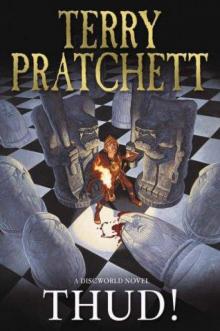 Thud!
Thud! Good Omens: The Nice and Accurate Prophecies of Agnes Nutter, Witch
Good Omens: The Nice and Accurate Prophecies of Agnes Nutter, Witch I Shall Wear Midnight
I Shall Wear Midnight Mort
Mort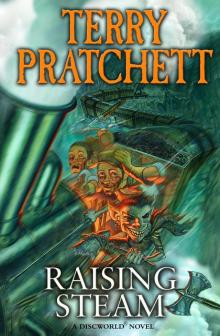 Raising Steam
Raising Steam Guards! Guards!
Guards! Guards!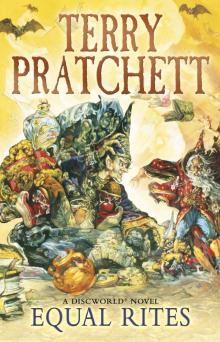 Equal Rites
Equal Rites A Hat Full of Sky
A Hat Full of Sky The Light Fantastic
The Light Fantastic Mrs Bradshaw's Handbook
Mrs Bradshaw's Handbook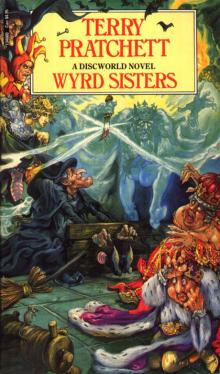 Wyrd Sisters
Wyrd Sisters Soul Music
Soul Music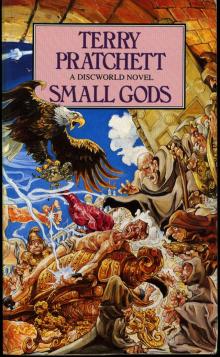 Small Gods
Small Gods Sourcery
Sourcery Reaper Man
Reaper Man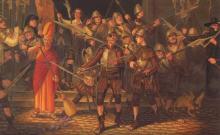 Night Watch
Night Watch Lords and Ladies
Lords and Ladies The Fifth Elephant
The Fifth Elephant Monstrous Regiment
Monstrous Regiment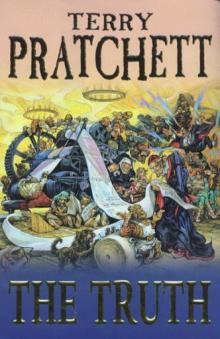 The Truth
The Truth Witches Abroad
Witches Abroad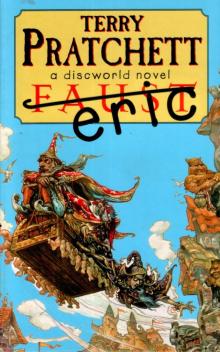 Eric
Eric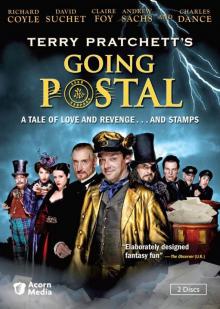 Going Postal
Going Postal Men at Arms
Men at Arms Jingo
Jingo The Amazing Maurice and His Educated Rodents
The Amazing Maurice and His Educated Rodents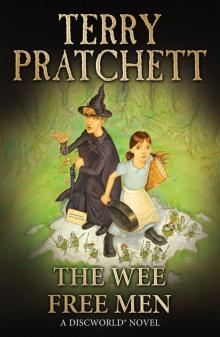 The Wee Free Men
The Wee Free Men Pyramids
Pyramids Wintersmith
Wintersmith Moving Pictures
Moving Pictures Carpe Jugulum
Carpe Jugulum Interesting Times
Interesting Times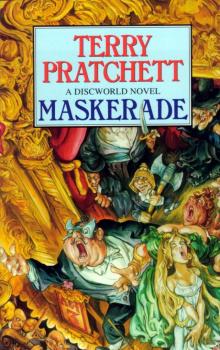 Maskerade
Maskerade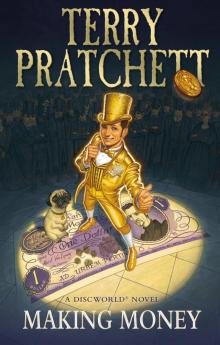 Making Money
Making Money The Shepherd's Crown
The Shepherd's Crown Hogfather
Hogfather Troll Bridge
Troll Bridge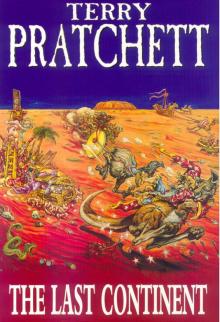 The Last Continent
The Last Continent The Sea and Little Fishes
The Sea and Little Fishes Snuff
Snuff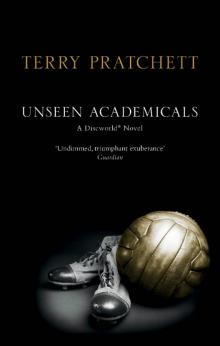 Unseen Academicals
Unseen Academicals Guards! Guards! tds-8
Guards! Guards! tds-8 Jingo d-21
Jingo d-21 Turtle Recall: The Discworld Companion ... So Far
Turtle Recall: The Discworld Companion ... So Far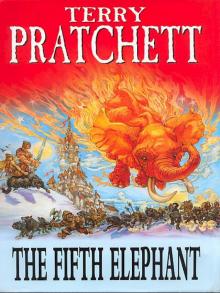 The Fifth Elephant d-24
The Fifth Elephant d-24 Discworld 39 - Snuff
Discworld 39 - Snuff The Long War
The Long War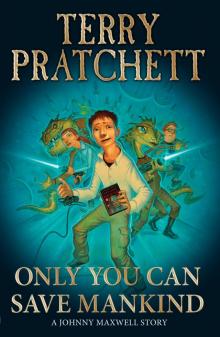 Only You Can Save Mankind
Only You Can Save Mankind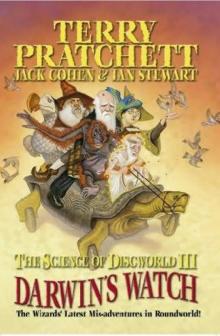 The Science of Discworld III - Darwin's Watch tsod-3
The Science of Discworld III - Darwin's Watch tsod-3 A Blink of the Screen: Collected Short Fiction
A Blink of the Screen: Collected Short Fiction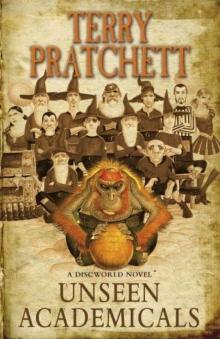 Unseen Academicals d-37
Unseen Academicals d-37 Wings
Wings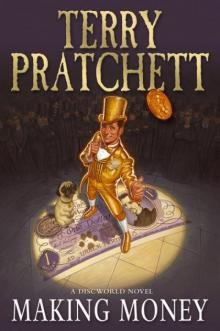 Making Money d-36
Making Money d-36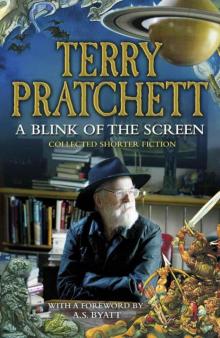 A Blink of the Screen
A Blink of the Screen Johnny and the Bomb
Johnny and the Bomb Dodger
Dodger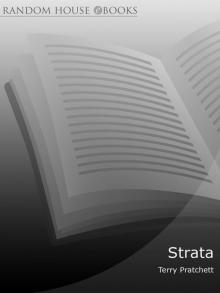 Strata
Strata Discworld 02 - The Light Fantastic
Discworld 02 - The Light Fantastic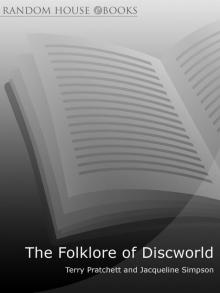 The Folklore of Discworld
The Folklore of Discworld The Science of Discworld
The Science of Discworld The Unadulterated Cat
The Unadulterated Cat Raising Steam: (Discworld novel 40) (Discworld Novels)
Raising Steam: (Discworld novel 40) (Discworld Novels) The World of Poo
The World of Poo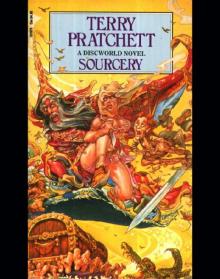 Discworld 05 - Sourcery
Discworld 05 - Sourcery The Witch's Vacuum Cleaner: And Other Stories
The Witch's Vacuum Cleaner: And Other Stories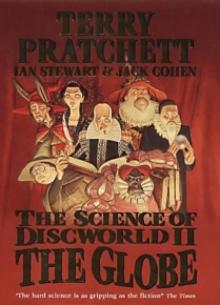 The Science of Discworld II - The Globe tsod-2
The Science of Discworld II - The Globe tsod-2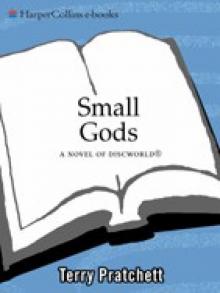 Small Gods: Discworld Novel, A
Small Gods: Discworld Novel, A Men at Arms tds-15
Men at Arms tds-15 Tama Princes of Mercury
Tama Princes of Mercury The Last Hero (the discworld series)
The Last Hero (the discworld series)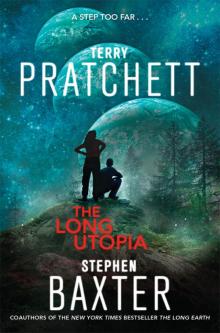 The Long Utopia
The Long Utopia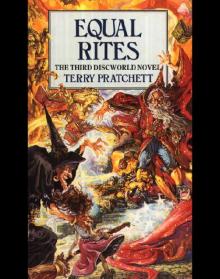 Discworld 03 - Equal Rites
Discworld 03 - Equal Rites Terry Pratchett - The Science of Discworld
Terry Pratchett - The Science of Discworld The Long Earth
The Long Earth The Carpet People
The Carpet People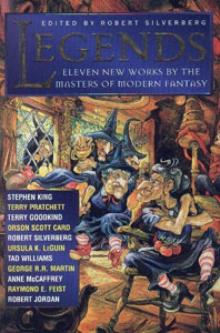 The Sea and Little Fishes (discworld)
The Sea and Little Fishes (discworld) The Colour of Magic
The Colour of Magic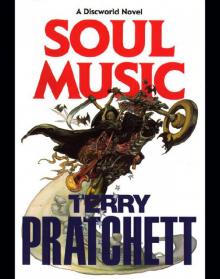 Discworld 16 - Soul Music
Discworld 16 - Soul Music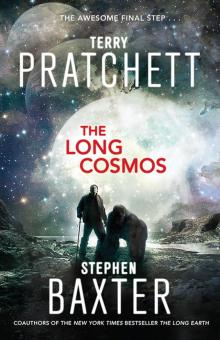 The Long Cosmos
The Long Cosmos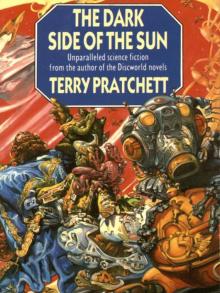 The Dark Side of the Sun
The Dark Side of the Sun Monstrous Regiment tds-28
Monstrous Regiment tds-28 The Bromeliad 3 - Wings
The Bromeliad 3 - Wings Dragons at Crumbling Castle: And Other Stories
Dragons at Crumbling Castle: And Other Stories Night Watch tds-27
Night Watch tds-27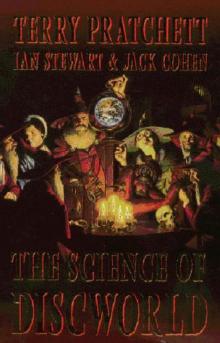 The Science of Discworld I tsod-1
The Science of Discworld I tsod-1 The Bromeliad 1 - Truckers
The Bromeliad 1 - Truckers The Science of Discworld Revised Edition
The Science of Discworld Revised Edition The Abominable Snowman
The Abominable Snowman Father Christmas’s Fake Beard
Father Christmas’s Fake Beard The Bromeliad Trilogy
The Bromeliad Trilogy A Slip of the Keyboard
A Slip of the Keyboard The Wee Free Men d(-2
The Wee Free Men d(-2 Johnny and the Dead
Johnny and the Dead Mrs Bradshaw's Handbook (Discworld Novels)
Mrs Bradshaw's Handbook (Discworld Novels)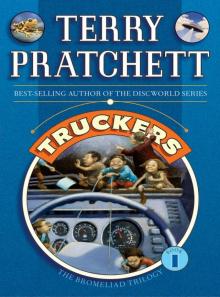 Truckers
Truckers The Amazing Maurice and His Educated Rodents d(-1
The Amazing Maurice and His Educated Rodents d(-1 Diggers
Diggers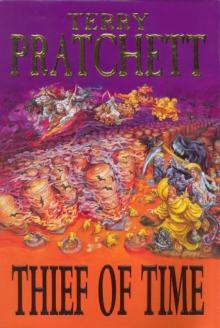 Thief of Time tds-26
Thief of Time tds-26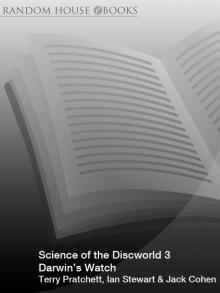 Science of Discworld III
Science of Discworld III Dragons at Crumbling Castle
Dragons at Crumbling Castle Nation
Nation Darwin's Watch
Darwin's Watch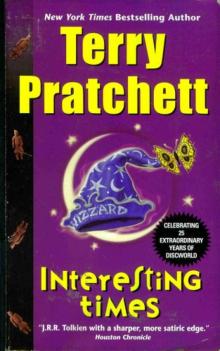 Interesting Times d-17
Interesting Times d-17 The Bromeliad 2 - Diggers
The Bromeliad 2 - Diggers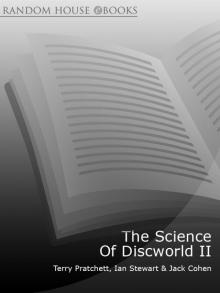 The Science of Discworld II
The Science of Discworld II